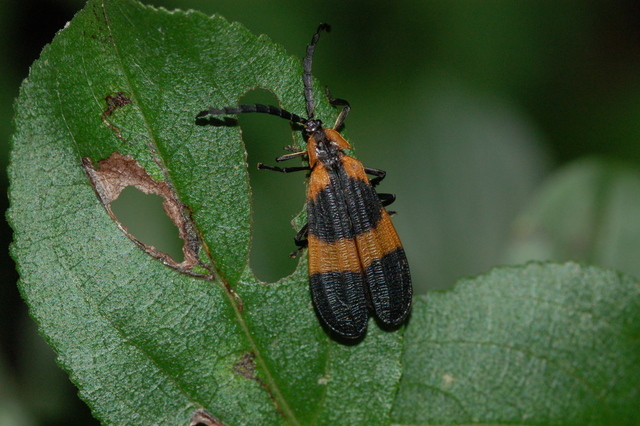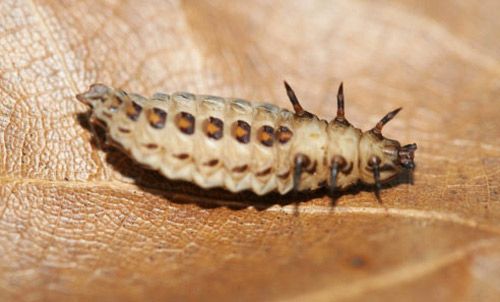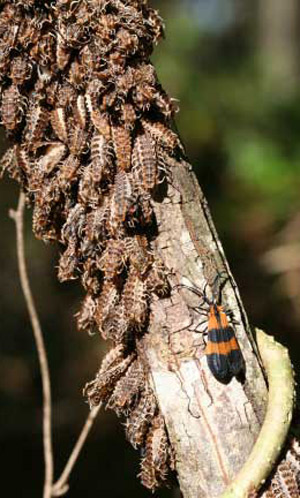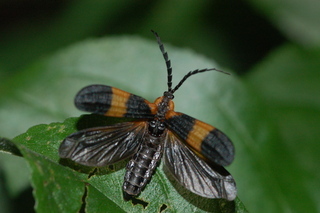How has Calopteron reticulatum evolved and how does it reproduce?
Over time, the wing colors and
patterns on C. reticulatum and other beetles in the
Lycidae family have evolved. According to a study conducted in
Asia performed by Bocak and Yagi (2010), these beetles have due
to their movement to different land environments have evolved
color change on their wings. Some of the beetles were observed
to have a lighter and more
 yellow color on their wings whereas
others had black, and orange on their wings. Split by water
bodies, these beetles were split by allopatric speciation which
in turn may have resulted in sympatric speciation which means
that even though the beetles may have been from the same
species, their wing color may have made such a difference that
they couldn't mate or reproduce. Additionally, these beetles may
have evolved their orange color on their wings to increase their
own defense against predators (Bocak and Yagi 2010).
In order for these beetles to mate, male beetles have to send
out chemical signals to attract and locate female beetles
(Grzimek 2004:319-322). After a male has attracted a female,
mating occurs. Once fertilization occurs, the eggs are laid in
the tunnel of a dead tree log or under tree bark(Grzimek 2004:
321; Bocak and Matsuda 2003). By hiding the eggs in the tunnel
of a dead tree or under a log, they eggs are less likely to be
eaten by a predator. Additionally, the eggs can take at least
two weeks to hatch and transform into the larval stage.
yellow color on their wings whereas
others had black, and orange on their wings. Split by water
bodies, these beetles were split by allopatric speciation which
in turn may have resulted in sympatric speciation which means
that even though the beetles may have been from the same
species, their wing color may have made such a difference that
they couldn't mate or reproduce. Additionally, these beetles may
have evolved their orange color on their wings to increase their
own defense against predators (Bocak and Yagi 2010).
In order for these beetles to mate, male beetles have to send
out chemical signals to attract and locate female beetles
(Grzimek 2004:319-322). After a male has attracted a female,
mating occurs. Once fertilization occurs, the eggs are laid in
the tunnel of a dead tree log or under tree bark(Grzimek 2004:
321; Bocak and Matsuda 2003). By hiding the eggs in the tunnel
of a dead tree or under a log, they eggs are less likely to be
eaten by a predator. Additionally, the eggs can take at least
two weeks to hatch and transform into the larval stage.
Larval Stage: Once C. reticulatum hatch out of
their eggs, they are considered larvae. The larvae are white in
color when they hatch and once they're out of their eggs, they
begin to eat. These larvae eat a variety of foods that range from eating other
organisms that share their habitat with them to drinking plant
juices. Near other organisms though, C. reticulatum
larvae are carnivorous because they eat the organism that they
are sharing a habitat with (Miller 1988). In addition to eating
other organisms and drinking plant juices, C. reticulatum
larvae also feed on
slime molds, decaying from which they hatch
from. As C. reticulatum eats, it grows longer and
longer until it reaches a length of approximately 10 to 15 mm
(Hall and Braham 2013).
larvae eat a variety of foods that range from eating other
organisms that share their habitat with them to drinking plant
juices. Near other organisms though, C. reticulatum
larvae are carnivorous because they eat the organism that they
are sharing a habitat with (Miller 1988). In addition to eating
other organisms and drinking plant juices, C. reticulatum
larvae also feed on
slime molds, decaying from which they hatch
from. As C. reticulatum eats, it grows longer and
longer until it reaches a length of approximately 10 to 15 mm
(Hall and Braham 2013).
: Pupal Stage:
Following the larval stage, C. reticulatum remains in
its i nstar exoskeleton and begins its pupal stage. It is
believed that C. reticulatum unlike other beetles may
actually save energy by staying in the same exoskeleton
throughout its larval and pupal stages (UW-Milwaukee 2013) Prior
to this stage, hundreds of full grown C. reticulatum
larvae will aggregate in one location of a tree where they begin
and finish their pupation stage. One theory to the aggregation
behavior of these beetles is that aggregation increases their
safety (Hall and Branham 2013). In addition to the pupa
aggregating for safety, their exoskeletons have black and orange
spikes on them. Additionally, once the pupa aggregate, they will
stay on the log for as long at two weeks or even months (Hall
and Branham 2013). These pupae do not eat or drink rather, they
stay in a dormant stage (University of Michigan).
nstar exoskeleton and begins its pupal stage. It is
believed that C. reticulatum unlike other beetles may
actually save energy by staying in the same exoskeleton
throughout its larval and pupal stages (UW-Milwaukee 2013) Prior
to this stage, hundreds of full grown C. reticulatum
larvae will aggregate in one location of a tree where they begin
and finish their pupation stage. One theory to the aggregation
behavior of these beetles is that aggregation increases their
safety (Hall and Branham 2013). In addition to the pupa
aggregating for safety, their exoskeletons have black and orange
spikes on them. Additionally, once the pupa aggregate, they will
stay on the log for as long at two weeks or even months (Hall
and Branham 2013). These pupae do not eat or drink rather, they
stay in a dormant stage (University of Michigan).
Adult stage: After staying dormant and not eating for a
period of time, the C. reticulatum pupa shed their last
instar exoskeleton and emerge as full grown adults(Hall and
Branham 2013). Once they emerge, some will fly away from
pupation site and some will stay (Hall and Branham 2003). These
newly emerged adults can be identified by the black and orange
banding pattern on their wings. These black and orange banding
patterns also give predators the signal that they should not eat
C. reticulatum beetles (Hall and Branham 2013). As
adults, they will mate by sending out chemical signals. Female
beetles can mate multiple times and each time they mate, not
only will their eggs be fertilized, but the extra sperm will be
stored within their bodies(Grzimek 2004: 321-322.). These adults
will also continue to feed on fermenting plant juices, slime
molds and decaying wood. One more point to keep in mind about
eating wood is that when these beetles eat wood, they are also
making tunnels for their eggs to grow and hatch into larvae
(Bocak and Matsuda 2003).
Come learn more about the Banded Net-Winged Beetle's Interactions
